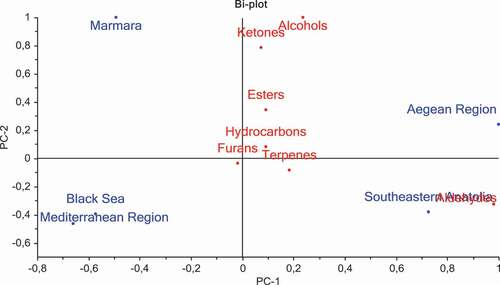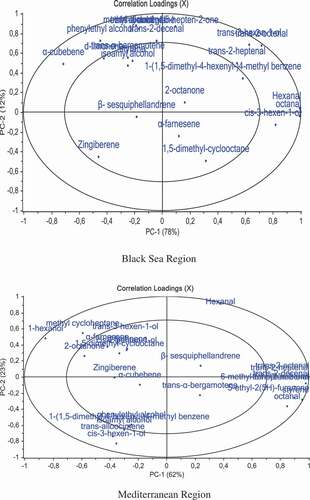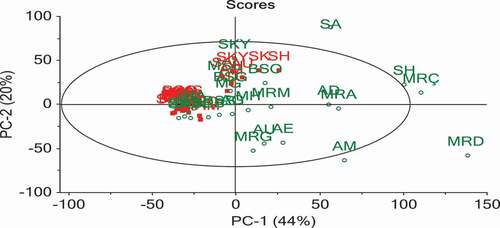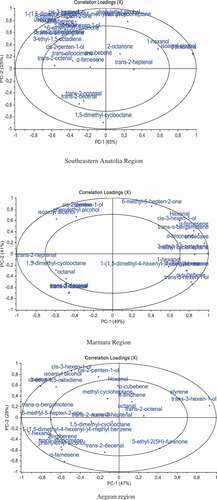ABSTRACT
In this research, changes in volatile compounds of olive oil were investigated in terms of cultivar, harvest year, and geographic regions (Mediterranean, Aegean, Southeastern Anatolia, Marmara, and Black Sea) were investigated. Volatile compounds of olive oils were extracted by using solid-phase microextraction (SPME) method and were identified with gas chromatography–mass spectrometry. A total of 59 volatile compounds from seven different chemical groups including aldehydes, ketones, hydrocarbons, alcohols, esters, terpenes, and furans were identified. Aldehydes were detected as the major group in all geographic regions. Among aldehydes, trans-2-hexenal was found to be relatively higher. Alcohols and esters were determined as other important compounds. While many volatile compounds were affected by olive cultivar factor, this factor had no significant effect on esters. Principal component analysis showed that volatile compounds could play an important role in the separation of regions.
Introduction
Olive oil, one of the oldest known oils, is generally produced in the Mediterranean basin, contains essential fatty acids and fat-soluble vitamins, and has its own taste and odor as well as a high digestibility degree and calorie value.[Citation1] Volatile compounds have a significant role in the aroma of olive oils. While a part of the volatile compounds in olive oil is comprised during the ripening of the fruit, a significant proportion is formed as result of enzymatic and chemical reactions, which occur during the oil processing. Enzymatic reactions influence especially in the formation of the compounds, which are responsible for the oil aroma, through lipoxygenase, whereas unpleasent odor compounds are generally formed by chemical oxidation reactions (oxidative rancidity).[Citation2] Important volatile compounds of quality olive oil are aldehydes, alcohols, esters, aromatic and aliphatic hydrocarbons, ketones, and furans. The composition of these compounds differs depending on the enzyme activity.[Citation3] Other factors that influence the volatile composition are cultivar,[Citation3–Citation5] ripeness,[Citation6] climate, region,[Citation3,Citation4] altitude,[Citation6] and technological factors (harvest, olive storage, washing, crushing, malaxing, extraction processes, and storage). The amount of the volatile compounds in olive oil is also related to the sensory quality.[Citation7]
Many olive cultivars are produced in different geographic regions of Turkey, an important olive oil producer. Among geographic region, Aegean is the most important region for olive oil production. Another important regions are the Marmara, the Mediterranean, Southeastern Anatolia, and the Black Sea regions. In Turkey, there are many olive cultivars. Some of them are endemic to the regions, such as Domat in the Aegean region, Saurani in the Mediterranean, Nizip Yağlık in Southeastern Anatolia, Butko in the Black Sea, and Çelebi in the Marmara regions, while some cultivars such as Gemlik, Memecik, and Ayvalık grow in many regions[Citation8,Citation9]. Studies on the determination of olive oil’s characteristic attributes have generally focused on the cultivars that are grown in Aegean and Marmara regions. These studies were conducted to determine the fatty acid composition of the olive oil[Citation10,Citation11] and antioxidant substances.[Citation12,Citation13] The researches on the volatile compound profile of the olive oil produced in Turkey have been carried out only for certain cultivars[Citation4,Citation14–Citation17] and regions.[Citation4,Citation6,Citation10,Citation16,Citation18] However, there are no extensive studies available for the volatile compounds of oil obtained from olives grown in different regions. In this study, the olive cultivars, which were commonly produced from five different geographic regions of Turkey, were harvested in two different harvest years and analyzed in terms of volatile compounds after being processed to the oil.
Materials and methods
Material
The olive fruits used in the research were provided from five geographic regions (). The samples were taken in November 2010 and 2011. In total, 50 samples—five cultivars from each region—were collected in two harvest years and processed to olive oil in the agricultural facilities located in the regions, where the samples had been taken from, through the three-phase extraction method. 500 mL was taken from each olive oil sample, put into brown glass bottles, and kept in dark until the analysis.
Table 1. Olive cultivars from different geographic regions.
Volatile profile
The extraction of volatile compounds was done by using solid-phase microextraction (SPME) technique according to the method described.[Citation3] Gas chromatography–mass spectrometry (GC/MS) was used to analyze the volatile compounds of olive oil samples. 20 g of olive oil sample was placed into a 40 mL SPME vial (Supelco, Bellefonte, PA, USA) sealed with a polytetrafluoroethylene-faced silicone septum (Supelco, Bellefonte, PA, USA). The vial was left at 45°C in a thermoblock (Supelco, Bellefonte, PA, USA) during 90 min with magnetic stirring . The DVB/CAR/PDMS fiber (50/30 µm, Supelco) which was absorbed by the volatile compounds was thermally desorbed into the injection port of the gas chromatography for 6 min at 250°C. The injector port was in the splitless mode. The volatile compounds were seperated on a HP-1 (Agilent, 50 m, 0.2 mm i.d., 0.55 μm film) column under the following conditions: helium flow rate, 1 mL/min; oven temperature programs, 1 min at 45°C, from 45°C to 230°C with a rate of 3°C min, held for 5 min at 230°C; detector and GC-MS interface temperatures, 250 and 280°C, respectively. Electron impact mass spectra were recorded at 70 eV, and data were acquired across the mass range 30–400 amu. Identification of volatile compounds was based on a comparison of the results with mass spectra from a database developed by NIST and WILEY or standards molecules (for calculating Kovats index, Supelco 44585-U, Bellefonte PA, USA).
Statistical analysis
The research was designed and carried out on the basis of the nested classification model considering five different regions, five cultivars from each region, and two harvest years. Research data were subjected to analysis of variance using the package program (IBM SPSS Statistics, version 20, Inc., Chicago, USA), and significant variation sources were compared by Duncan’s multiple range test. The relationship between volatile compounds depending on cultivars, harvest year, and regions was also evaluated by principal component analysis (PCA) using Unscrambler v10. 01. (Como Process, A. S., Norway). In PCA, the size of data matrix was 50 × 29.
Result and discussion
Averages and statistical analysis results related to volatile compounds of olive oil samples, obtained from olive cultivars in different geographic regions, are given in . Thirteen different aldehydes were detected in the samples, and the trans-2-hexenal was the major compound among those compounds in all the regions. While compound differences between the cultivars in the regions were found to be insignificant (P˃0.05), harvest year had a statistically significant effect on trans-2-hexenal (P˂0.01) (). The highest average of trans-2-hexenal was observed in the Aegean region. It was also reported in some studies that trans-2-hexenal is quite important in olive oil aroma profiles.[Citation1,Citation4–Citation6,Citation15–Citation20]
Table 2. Overall effect of region, cultivar, and harvest year factors on volatile compounds of olive oil (means ± SD) (AU×10−6).
Among the aldehydes, hexanal, following trans-2-hexenal except Mediterranean region, was another important compound (). Runcio et al.[Citation21] reported that trans-2-hexenal was the compound mostly found in the volatile compound profile following hexanal in oils of some olive cultivars that were grown in Italy. The harvest year factor did not have any important effects (P˃0.05) on the amount of hexanal, which is one of the 6-carbon aldehydes formed through the lipoxygenase pathway. On the other side, some differences were found out between the cultivars in terms of hexanal (). In the present study, the lowest peak area amount of hexanal was detected in the Black Sea region. In our other study on same samples, it was also determined that the Black Sea region showed the lowest linolenic acid content.[Citation22] Moreover, in another study conducted on same samples, it was demonstrated that K232 and K270, primer and seconder oxidation pathways, respectively, showed the lowest values in Black Sea region.[Citation7] These results indicated that the formation of some volatile compounds is affected by fatty acid composition of olive oil.
Nonanal is another important compound among the aldehydes in terms of amount. Both the region and the year had a very significant effect (P˂0.01) on this compound, while cultivar had no significant effect (P˃0.05) (). Aldehydes appeared as a major group in this research. Similar results were found in some other studies as well.[Citation3,Citation17] Besides, it was reported that the saturated carbonyl compounds such as nonanal, pentanal, heptanal, and hexanal were major compounds in the oxidized olive oil.[Citation23,Citation24]
In the research, four different ketones were identified in olive oil samples. The 6-methyl-5-hepten-2-one ratio showed high values among the ketones in all of the regions. The highest average value was detected in the Marmara region (). In total, 15 hydrocarbons were found in olive oil samples. Styrene had the highest average value among these compounds. 3-Ethyl-1,5-octadiene was found in higher proportions in the Aegean and Southeastern Anatolia regions. This compound was not affected by the year factor (P˃0.05). However, cultivar had a very significant effect (P˂0.01) on this compound. Toluene, octane, and 3-ethyl-1,5-octadiene were also detected in the research conducted by Kıralan et al.,[Citation6] and it was observed that the compounds like toluene, xylene, and ethyl benzene resulted from environmental contaminations.
Alcohols, which are among the 6-carbon compounds, have an important role in the characteristic aroma of olive oil. Alcohols are comprised of linoleic and linolenic acids enzymatically through the lipoxygenase pathway.[Citation18] In total, 12 different alcohols were found in olive oil samples. Among the alcohols, 1-hexanol showed higher values in the Aegean and Southeastern Anatolia when compared to the other regions (). Also, trans-3-hexen-1-ol showed a higher value in the Marmara region. Cavalli et al.[Citation3] reported that cis-3-hexenol (2.9–4.6%), trans-2-hexenol (2.7–9.0%), and hexanol (3.6–7.8%) in the French (Cailletier and Blanquettier) and Spanish (Arbequines) olive oils were the most important compounds among the alcohols. 1-Penten-3-ol, 3-methyl-1-butanol and phenylethyl alcohol were found in a study on the olives of Gemlik cultivar by Kıralan et al.[Citation6] Gomez-Rico et al.[Citation25] determined 1-hexanol, cis-3-hexen-1-ol and trans-2-hexen-1-ol, which are 6-carbon alcohols, in different cultivars. Ilyasoğlu et al.[Citation18] also detected hexanol, cis-3-hexenol, and cis-2-hexenol in the olive oil produced from the Ayvalık and Memecik cultivars. In some other researches, different alcohols were found in varied proportions depending on the cultivar and the harvest year.[Citation16,Citation23,Citation25–Citation28] Moreover, it was specified that volatile alcohols such as propanol, amyl alcohol, 2-hexenol, 2-hexanol and heptanol, and volatile aldehydes such as octanal, nonanal, and 2-hexanal could be used in the characterization of the olive cultivar.[Citation23]
Besides aldehydes and alcohols, esters are also important for the characteristic aroma of olive oil. Six different ester compounds were found and hexyl acetate had the highest amount. Both the region and the year had a significant effect (P˂0.01) on this compound. When esters were generally evaluated, it was concluded that the Marmara and the Aegean regions came into prominence. Krichene et al.[Citation19] identified cis-3-hexenyl acetate and hexyl acetate in some Tunisian olive oil samples. In another study, three different esters (cis-3-hexenyl acetate, hexyl acetate, and ethyl-2-methyl butanoate) were detected in Gemlik olive oil.[Citation4] In a research on Greek olive oil, it was determined that esters showed lower values than aldehydes and ketones, and hexyl and cis-3-hexenyl acetate constituted a significant part of the esters.[Citation20]
As terpenes, α-farnesene, p-ocimene, D-limonene, α-cubebene, zingiberene, trans-allocimene, trans-α-bergamoten, and β-sesquiphellandrene were identified in olive oil samples. Both the region and the cultivar resulted in statistically significant differences (P˂0.01) on the α-farnesene, D-limonene, α-cubebene, trans-α-bargamoten, β-sesquiphellandrene, and zingiberene compounds. D-Limonene showed the highest average value in the Southeastern Anatolia, α-cubebene, and p-ocimene in the Aegean region, α-farnesene and trans-α-bargamoten in the Black Sea region, and β-sesquiphellandrene in the Mediterranean region (). Kaftan and Elmacı[Citation16] detected many terpenes including limonene, zingiberene, allocimene, β-sesquiphellandrene, and α-farnesene in Memecik and Ayvalık cultivars of the Aegean region.
Only 2-octyl furan was found in olive oil samples. This compound was not found in the Aegean and the Marmara regions. Kıralan et al.[Citation6] defined 2-ethyl furan and 2-pentyl furan in Gemlik olive oil samples obtained from different regions. Furans are colorless, lipophilic, and quite volatile compounds with low molecule weights. It is noted that furan formation from unsaturated fatty acids is associated with the lipid oxidation.[Citation29]
In this study, PCA was applied to assess the relationships between regions and chemical groups of volatile compounds (), the differences between volatile compounds depending on the region (), and also the effects of harvest year on cultivar (). Biplot in showed that the Aegean and Southeastern regions located at positive side on PC1 (73%) for alcohols, ketones, esters, hydrocarbons, terpenes, and aldehydes except furans. On the other hand, the Aegean and the Marmara regions located at positive side on PC2 (26%) for all of chemical groups except terpenes and furans. The Black sea and the Mediterranean regions were negative correlation with both PC1 and PC2.
Figure 1. Principal component analysis biplot of relationships between regions and chemical groups of volatile compounds.

Figure 2. Loading plots of principal component analysis (PCA) results obtained from volatile compounds of regions.

Figure 3. Loading plots of principal component analysis results obtained from harvest year of cultivars (red color: first year; green color: second year) (abbreviations are given in ).

Two principal components were able to explain 85%, 75%, 88%, 90%, and 90% of the total variance observed in the Mediterranean, the Aegean, Southeastern Anatolia, the Marmara, and the Black Sea, respectively (). In the Mediterranean region, aldehydes are located at the positive side, while alcohols correlated with negative side of PC1. On the other hand, all of alcohols and aldehydes except 1-hexanol and trans-2-decenal are placed at the positive side of PC2 for the Aegean region. It was observed that volatile compounds are located intensely at positive side on PC2 for Southeastern Anatolia region. While similar results were determined for the Black Sea region, the Marmara region showed unlike results ().
The results of PCA at different harvest years of cultivars to each region are given in . Two principal components were able to explain 64% (). The cultivars are located generally at negative side of PC1 and at the positive side of PC2 at the first harvest year, while cultivar was very variable at the second harvest year (.). The same cultivar can give different results in different regions and at different years. For example, Gemlik cultivar gave different results in the second harvest year in the Marmara region than the Mediterranean and the Aegean regions, while similar results were observed in the first harvest year in all three regions. This situation can be seen in . It is also added to the manuscript. Being said that, same cultivars belonging to different regions also gave different results. For example, Gemlik variety was localized at a quite different position in the Marmara region at the second harvest year when compared to the Mediterranean region. In the contrary, the same variety gave similar results in different regions at the first harvest year.
Consequently, it has been determined that aldehydes play an important role within the volatile compound profile in all the regions and trans-2-hexenal is a major compound. The alcohols and esters follow aldehydes are not affected by the cultivar factor. As another important result, it is found that cultivar factor on the volatile profile is more effective than the harvest year.
Acknowledgments
This research was supported by Research Council of Atatürk University (BAP-2010/253).The financial support of Atatürk University is gratefully acknowledged.
References
- Nas, S.; Gökalp, H.Y.; Ünsal, M. Bitkisel Yağ Teknolojisi; Pamukkale University press, No:005: Denizli, Turkey, 2001.
- Kalua, C.M.; Allen, M.S.; Bedgood, D.R.; Bishop, A.G.; Prenzler, P.D.; Robards, K. Olive Oil Volatile Compounds, Flavour Development and Quality: A Critical Review. Food Chemistry 2007, 100, 273–286. DOI: 10.1016/j.foodchem.2005.09.059.
- Cavalli, J.F.; Fernandez, X.; Lizzani-Cuvelier, L.; Loiseau, A.M. Characterization of Volatile Compounds of French and Spanish Virgin Olive Oils by HS-SPME: Identification of Quality-Freshness Markers. Food Chemistry 2004, 88, 151–157. DOI: 10.1016/j.foodchem.2004.04.003.
- Bayrak, A.; Kiralan, M.; Kara, H.H. Determination of Aroma Profiles of Olive Oils from Turkish Olive Cultivars. Journal of the American Oil Chemists Society 2013, 90, 1281–1300. DOI: 10.1007/s11746-013-2284-2.
- Cecchi, T.; Alfei, B. Volatile Profiles of Italian Monovarietal Extra Virgin Olive Oils via HS-SPME-GC-MS: Newly Identified Compounds, Flavors Molecular Markers, and Terpenic Profile. Food Chemistry 2013, 141, 2025–2035. DOI: 10.1016/j.foodchem.2013.05.090.
- Kiralan, M.; Ozkan, G.; Koyluoglu, F.; Aşık-Uğurlu, H.; Bayrak, A.; Kiritsakis, A. Effect of Cultivation Area and Climatic Conditions on Volatiles of Virgin Olive Oil. European Journal of Lipid Science and Technology 2012, 114, 552–557. DOI: 10.1002/ejlt.201100289.
- Şişik Oğraş, Ş.; Identification of Volatile Compounds and Some Other Qualitative Characteristics of Olive Oils from Different Geographic Regions. Ph. D. Thesis, Atatürk University, Turkey, 2014.
- Güler, M.; Cesur, R.; Sarı, N. Zeytinde Bakım İşlemleri; P:38, Doğu Akdeniz Zeytin Birliği: Adana, Turkey, 2010.
- Food, Agriculture and Livestock Ministry (FALM) of Turkish Republic, Olive Research Station. Native Species Catalogue.Arastirma.Tarim.Gov.Tr/Izmirzae; İzmir, Turkey: Zeytincilik Araştırma Enstütüsü. Accessed: April 2018. 2012.
- Dıraman, H.; Dibeklioğlu, H. Characterization of Turkish Virgin Olive Oils Produced from Early Harvest Olives. Journal of the American Oil Chemists Society 2009, 86, 663–674. DOI: 10.1007/s11746-009-1392-5.
- İlyasoğlu, H.; Özçelik, B.; Hoed, V.V.; Verhe, R. Characterization of Aegean Olive Oils by Their Minor Compounds. Journal of the American Oil Chemists Society 2010, 87, 627–636.
- Öğütçü, M.; Mendeş, M.; Yılmaz, E. Sensorial and Physico-Chemical Characterization of Virgin Olive Oils Produced in Çanakkale. Journal of the American Oil Chemists Society 2008, 85, 441–456. DOI: 10.1007/s11746-008-1220-3.
- Öğütçü, M.; Yılmaz, E. Comparison of the Virgin Olive Oils Produced in Different Regions of Turkey. Journal of Sensory Studies 2009, 24, 332–353. DOI: 10.1111/j.1745-459X.2009.00214.x.
- Kıralan, M.; Bayrak, A.; Özkaya, M.T. Oxidation Stability of Virgin Olive Oils from Some Important Cultivars in East Mediterranean Area in Turkey. Journal of the American Oil Chemists Society 2009, 86, 247–252. DOI: 10.1007/s11746-008-1337-4.
- İlyasoğlu, H.; Özçelik, B. Memecik Zeytinyağlarının Bölgesel Karakterizasyonu. Gıda 2011, 36(1), 33–41.
- Kaftan, A.; Elmacı, Y. Aroma Characterization of Virgin Olive Oil from Two Turkish Olive Varieties by SPME/GC/MS. International Journal of Food Properties 2011, 14, 1160–1169. DOI: 10.1080/10942910903453371.
- Kesen, S.; Kelebek, H.; Selli, S. Characterization of the Volatile,Phenolic and Antioxidant Properties of Monovarietal Olive Oil Obtained from Cv. Halhalı. Journal of the American Oil Chemists Society 2013, 90, 1685–1696. DOI: 10.1007/s11746-013-2327-8.
- İlyasoğlu, H.; Özçelik, B.; Hoed, V.V.; Verhe, R. Cultivar Characterization of Aegean Olive Oils with respect to Their Volatile Compounds. Scientia Horticulturae 2011, 129, 279–282. DOI: 10.1016/j.scienta.2011.03.048.
- Krichene, D.; Allalout, A.; Salvador, M.D.; Fregapane, G.; Zarrouk, M. Fatty Acids, Volatiles, Sterols and Teriterpenic Alcohols of Six Monovarietal Tunisian Virgin Olive Oils. European Journal of Lipid Science and Technology 2010, 112, 400–409. DOI: 10.1002/ejlt.200900095.
- Vekiari, S.A.; Oreopolou, V.; Kourkoutas, Y.; Kamoun, N.; Msallem, M.; Psimouli, V.; Arapoglou, D. Characterization and Seasonal Variation of the Quality of Virgin Olive Oil of the Throumbolia and Koroneiki Varieties from Southern Greece. Gras. Y Aceites 2010, 61(3), 221–231. DOI: 10.3989/gya.108709.
- Runcio, A.; Sorgona, L.; Mincione, A.; Santacaterina, S.; Poiana, M. Volatile Compounds of Virgin Olive Oil Obtained from Italian Cultivars Grown in Calabria. Effect of Processing Methods, Cultivar, Stone Removal, and Antracnose Attack. Food Chemistry 2008, 106(2), 735–740. DOI: 10.1016/j.foodchem.2007.06.051.
- Şişik Oğraş, Ş.; Kaban, G.; Kaya, M. The Effects of Geographic Region, Cultivar and Harvest Year on Fatty Acid Composition of Olive Oil. Journal of Oleo Science 2016, 65(11), 889–895. DOI: 10.5650/jos.ess15270.
- Synder, J.M.; Frankel, E.N.; Selke, E. Capillary Gas Choromatographic Analyses of Headspace Volatiles from Vegetable Oils. Journal of the American Oil Chemists Society 1985, 62, 1675–1679. DOI: 10.1007/BF02541664.
- Kristakis, A.K. Flavor Components of Olive Oil-A Review. Journal of the American Oil Chemists Society 1998, 75(6), 673–681. DOI: 10.1007/s11746-998-0205-6.
- Gomez-Rico, A.; Fregapane, G.; Salvador, M.D. Effect of Cultivar and Ripening on Minör Components in Spanish Olive Fruits and Their Corresponding Virgin Olive Oils. Food Research. International 2008, 41, 433–440. DOI: 10.1016/j.foodres.2008.02.003.
- Baccouri, O.; Bendini, A.; Cerretani, L.; Guerfel, M.; Baccouri, B.; Lercker, G.; Zarrouk, M.; Miled, D.D.B. Comparative Study on Volatile Compounds from Tunusian and Sicilian Monovarietal Virgin Olive Oils. Food Chemistry 2008, 111, 322–328. DOI: 10.1016/j.foodchem.2008.03.066.
- Queslati, I.; Haddada, F.M.; Manai, H.; Zarrouk, W.; Taamalli, W.; Fernandez, X.; Lizzani-Cuvelier, L.; Zarrouk, M. Characterization of Volatiles in Virgin Olive Oil Produced in the Tunusian Area of Tataouine. Journal of Agriculture and Food Chemistry 2008, 56, 7992–7998. DOI: 10.1021/jf801022c.
- Issaoui, M.; Flamini, G.; Brahmi, F.; Dabbou, S.; Hassine, K.B.; Taamali, A.; Chehab, H.; Ellouz, M.; Zarrouk, M.; Hammami, M. Effect of Growing Area Conditions on Differentiation between Chemlali and Chetoui Olive Oils. Food Chemistry 2010, 119, 220–225. DOI: 10.1016/j.foodchem.2009.06.012.
- Tura, D.; Failla, O.; Bassi, D.; Attilio, C.; Serraiocco, A. Regional and Cultivar Comparison of Italian Single Cultivar Olive Oils according to Flavor Profiling. European Journal of Lipid Science and Technology 2013, 115, 196–210. DOI: 10.1002/ejlt.201200104.

